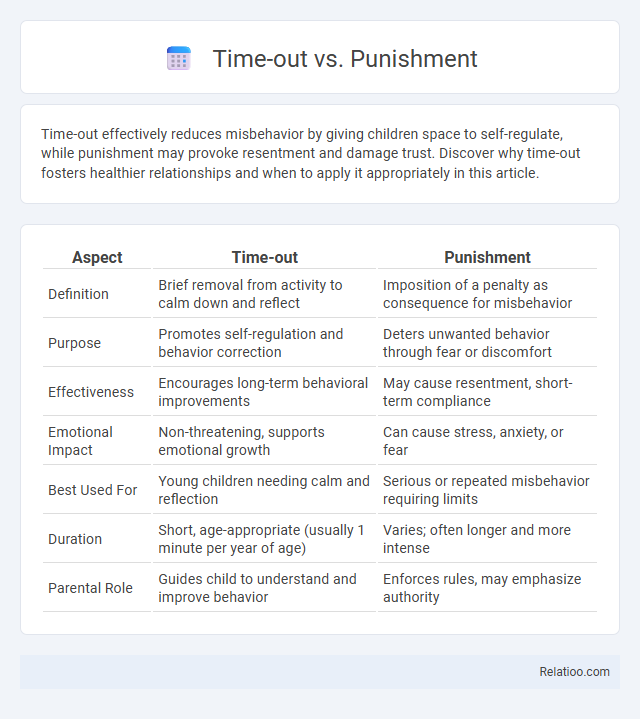Time-out effectively reduces misbehavior by giving children space to self-regulate, while punishment may provoke resentment and damage trust. Discover why time-out fosters healthier relationships and when to apply it appropriately in this article.
Table of Comparison
| Aspect | Time-out | Punishment |
|---|---|---|
| Definition | Brief removal from activity to calm down and reflect | Imposition of a penalty as consequence for misbehavior |
| Purpose | Promotes self-regulation and behavior correction | Deters unwanted behavior through fear or discomfort |
| Effectiveness | Encourages long-term behavioral improvements | May cause resentment, short-term compliance |
| Emotional Impact | Non-threatening, supports emotional growth | Can cause stress, anxiety, or fear |
| Best Used For | Young children needing calm and reflection | Serious or repeated misbehavior requiring limits |
| Duration | Short, age-appropriate (usually 1 minute per year of age) | Varies; often longer and more intense |
| Parental Role | Guides child to understand and improve behavior | Enforces rules, may emphasize authority |
Understanding Discipline: Time-out vs Punishment
Understanding discipline requires distinguishing time-out from punishment, as time-out serves as a non-punitive strategy designed to reduce undesirable behavior by temporarily removing a child from a stimulating environment. Punishment involves imposing negative consequences to discourage behavior, which can sometimes lead to fear or resentment rather than learning. Time-out emphasizes self-regulation and reflection, promoting positive behavioral changes without damaging the parent-child relationship.
Defining Time-out: Principles and Purpose
Time-out is a behavioral strategy designed to reduce undesirable actions by temporarily removing a child from an environment where inappropriate behavior occurs, allowing them to calm down and reflect. It operates on principles of negative punishment, where access to positive reinforcement is withheld to decrease the likelihood of the behavior recurring. The primary purpose of time-out is to promote self-regulation and teach children appropriate responses without resorting to physical or verbal punishment.
What Constitutes Punishment in Child Discipline?
Punishment in child discipline involves introducing a consequence that reduces the likelihood of an undesirable behavior recurring by applying something unpleasant or removing something desired. Time-out is a specific form of punishment where a child is temporarily removed from an environment to decrease negative behavior, while other punishments may include verbal reprimands or loss of privileges. Understanding what constitutes punishment helps Your approach focus on effective strategies that promote positive behavior change without causing emotional harm.
Psychological Effects of Time-Outs
Time-out is a behavioral intervention focusing on removing a child from a reinforcing environment to reduce undesirable actions, promoting self-regulation and reflection. Unlike punishment, which often elicits fear or resentment, time-outs foster emotional self-control without damaging the child's self-esteem. Research demonstrates that properly applied time-outs encourage positive behavior changes and improve emotional resilience by providing a calm space for children to process their emotions.
Impact of Punishment on Child Behavior
Punishment often leads to increased fear, anxiety, and aggression in children, negatively impacting their emotional well-being and hindering long-term positive behavior change. Unlike time-out, which encourages reflection and self-regulation by temporarily removing the child from a triggering situation, punishment can provoke resistance and resentment. Your approach to discipline should prioritize methods that promote understanding and emotional growth rather than instilling fear or shame.
Time-Out: Pros, Cons, and Best Practices
Time-out is an effective behavioral strategy that temporarily removes a child from a stimulating environment to encourage self-regulation and reflection, promoting positive behavior changes. Pros include its non-physical nature and clear consequences, while cons involve potential misuse or overuse that can lead to feelings of isolation or resentment. Your best practice involves consistent application, brief durations appropriate to the child's age, and coupling time-outs with calm explanations to reinforce understanding and growth.
Punishment: Pros, Cons, and Potential Risks
Punishment can provide immediate behavior correction by imposing consequences, reinforcing discipline and deterring undesirable actions. However, it often risks fostering fear, resentment, and long-term emotional harm, potentially damaging trust and communication between individuals. Ineffective punishment may lead to increased aggression, decreased self-esteem, and a failure to teach alternative positive behaviors.
Comparing Effectiveness: Time-out vs Punishment
Time-out and punishment differ significantly in effectiveness for behavior management, with time-out promoting reflection and self-regulation by temporarily removing a child from reinforcing environments. Punishment, often involving negative consequences, may suppress undesirable behavior short-term but risks increased aggression and anxiety without teaching alternative behaviors. Research shows time-out supports long-term behavioral improvements with less emotional distress compared to punishment, making it a preferred strategy in child psychology and educational settings.
Expert Opinions: What Do Psychologists Recommend?
Psychologists generally recommend time-outs over traditional punishment because time-outs promote self-regulation and reduce negative behaviors without damaging the parent-child relationship. Experts emphasize that effective time-outs should be brief, calm, and consistent, allowing children to cool down and reflect on their actions. Punishment, especially harsh or physical forms, is often discouraged due to its association with increased aggression and anxiety in children.
Healthy Discipline Strategies for Positive Parenting
Time-out, punishment, and positive discipline each play distinctive roles in healthy parenting strategies, with time-out serving as a non-punitive method to help children self-regulate and reflect on their behavior. Punishment often involves penalties or negative consequences, which can damage parent-child relationships and hinder emotional development, whereas effective time-out techniques focus on creating calm spaces for children to regain control without feelings of shame. Positive parenting emphasizes consistent boundaries, empathy, and reinforcement of good behavior, making time-out a valuable tool for fostering respect and understanding rather than fear or resentment.

Infographic: Time-out vs Punishment
 relatioo.com
relatioo.com